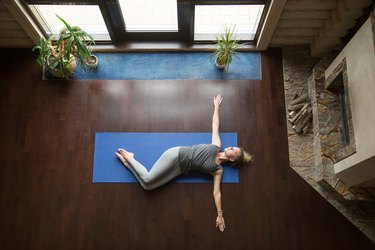
Spondylolisthesis causes back pain due to instability in the vertebrae. Teens who are involved in sports like football or gymnastics are at risk. It is important to know which spondylolisthesis exercises to avoid for preventing injury, as well as which ones are best for a strong core.
Overview of Spondylolisthesis
Video of the Day
You may be surprised to find out that spondylolisthesis is the most common cause of back pain for teen athletes, as reported by the Cleveland Clinic. Those who are involved in sports that put stress on the back, such as gymnastics, weight lifting or football, are at greater risk. Degenerative spondylolisthesis causes low back pain in those who are middle-aged or older than 40.
Video of the Day
Spondylolisthesis is a stress fracture in one of the vertebrae in your back, resulting in the vertebrae shifting or slipping out of place, explains the American Academy of Orthopaedic Surgeons (AAOS). It most commonly occurs at the fifth lumbar vertebra.
Even though it sounds serious, the symptoms of a low-grade spondylolisthesis can be somewhat mild, says the AAOS. You may feel low back pain, similar to a muscle strain, which may radiate down the buttock and back of the thighs. The pain often increases with activity and will improve with rest.
Doctors will rate the spondylolisthesis as low grade or high grade, depending on how much the vertebrae have slipped forward. Patients with low-grade slips have fewer symptoms and will respond well to conservative treatment, such as exercise. Those with high-grade slips may experience tingling and numbness or weakness in their legs and may need surgery.
Considering these risks, it's very important to know what to avoid with spondylolisthesis to prevent further injury.
Read more: What Causes Low Back Pain During Exercise?
Spondylolisthesis Exercises to Avoid
For those who are looking to rehabilitate a non-operative spondylolisthesis, expect it to take three to six months to heal, says Sanford Orthopedics Sports Medicine. For optimal healing, they recommend a break in sports for teen athletes for at least three months. Some patients may also require wearing a brace for a period of time.
In addition to rest and bracing, there are several things to avoid with spondylolisthesis. Once your doctor has given you the clear, it's important to engage in regular exercise to improve your strength and flexibility.
Since this condition creates instability in your back, it is crucial to strengthen the core muscles that support your spine to provide stability and prevent future injuries. It is equally as important to know what not to do.
Spondylolisthesis exercises to avoid include those lumbar extension movements that take your spine past the neutral position, states Sanford Orthopedics Sports Medicine. This extension motion may increase pain and impede the healing of the affected vertebrae. Here are some examples of extension exercises to avoid:
- Prone press-ups (lying on your stomach and pushing up).
- Standing extensions.
- Prone leg raises (lying on your stomach and lifting your legs).
- Back extension machine at the gym.
It is best to avoid yoga until your doctor gives you the all-clear. There are many back-extension movements in yoga, including the cobra and swan, which may not be safe.
Other things to avoid with spondylolisthesis include weightlifting, activities that require twisting or bending and high-impact activities that put too much stress on your healing back, such as jumping rope or box jumps.
Best Exercises for Spondylolisthesis
Now that you know which spondylolisthesis exercises to avoid, what are the best exercises for your healing back? In general, rehabilitation focuses on strengthening your core muscles without going past neutral, as well as hamstring stretches. Expect it to take three to six months of rehabilitation before you are ready to return to sports.
The University of Wisconsin Sports Medicine recommends the following exercises initially:
- Pelvic tilts.
- Hamstring stretches (lie on your back and use straps to raise your leg to 90 degrees).
- Light exercise on the stationary bike.
Progress to the following exercises after four to eight weeks of rest, as suggested by the University of Wisconsin Sports Medicine:
- Crunches.
- Double leg bridges.
- Side planks.
- Stationary biking.
- Sit on a therapy ball and alternate lifting an arm or leg.
In two to three months, you can begin doing sit-ups, squats and push-ups. You can also start using an elliptical machine or jog in chest-deep water.
Check with your doctor before starting any exercise program when recovering from this injury. Aim for a gradual return to sports activities, depending on the severity of your condition and how strong your core is.
Once healed, teens may continue to do core strengthening and stretches to prevent future injuries. Also, it's recommended to take breaks from high-risk sports, such as gymnastics, wrestling, volleyball, football and weight lifting.
- Cleveland Clinic: "Spondylolisthesis"
- American Academy of Orthopaedic Surgeons: "Spondylolysis and Spondylolisthesis"
- Sanford Orthopedics Sports Medicine: "Lumbar Spondylolysis/listhesis Rehabilitation Guideline"
- University of Wisconsin Sports Medicine: "Rehabilitation Guidelines for Lumbar Spondylolysis/Spondylolisthesis"
Is this an emergency? If you are experiencing serious medical symptoms, please see the National Library of Medicine’s list of signs you need emergency medical attention or call 911.